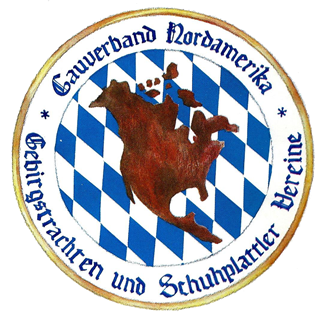Gauverband Nordamerika
dedicated to preserving and perpetuating the cultural heritage of Bavaria and Tyrol
You are here
Gauverband I Website - Volkstanz Instruction w/links to audio
Updated by Karin Dean-Kraft, Gaupressewart, November 2011 (Originally added in 2009)
Good news for those who are always on the lookout for sources of instruction for Volkstaenze! Gauverband I has a wonderful section on its website (go to www.gauverband1.de, then click on "Taenze" or go to www.gauverband1.de/Tanze/tanze.html). The site contains instructions (in German) for 26 Volkstaenze, as well as several photos of each dance to show detail. There's also a section that shows the most used Tanzfassungen (dance positions). You'll notice that the dancers are all from the Chiemgau - Chiemgauer dance on their toes and their outstretched arms are generally held very high and straight. It is not necessary to do this if your group does not do Chiemgauer-style dancing. Notice too the lovely Gretlfrisur that the ladies are wearing and their Tanztracht. The men are not wearing ties or vests, typical of Tanztracht for the region. The dances include Auftanz, Boarischer, Bauernmadl, Italiener, Kreuzpolka, Knoedldrahner, Neuboarisch, Salzburger Dreher, Waldjager, and Zwiefacher, to name just some. Some background information about the origin of each dance is also included.
Hildegard Kallmaier is the Volkstanzwartin in Gauverband I in Bayern. Below is a translation of her introduction to the new "Tanzen" website:
"Volkstaenze in Bayern was once connected to customs (Schwertertanz or sword dance) or profession (Schaefflertanz or coopers dance; Webertanz or weavers dance). Other influences are also seen such as military (Marschierpolka), immigrant workers (Italiener), migrant harvest workers from the east (Mazurka), traveling salesmen, German-speaking settlers to other lands such as Boehmen or Galizien, shipping people (Rheinlaender) and even the court dances of royalty (Francaise). With the onset of modern dance - especially after the two World Wars -- folk dancing was being pushed aside. Some people had great presence of mind, however, and took it upon themselves to preserve and disseminate Volkstaenze. One of these people is Erna Schuetzenberger who, along with Prof. Derschmidt, published a 5-volume series in 1930 entitled "Spinnradl - Unser Tanzbuch."
"Georg von Kaufmann, a forester and dance master, published other oberbayerische Volkstaenze. Besides dances in the round like Landler, Polka, and Dreher, they disseminated figure dances that are known for their simple figures and melodies. Round and figure dances are done by people of all ages and occupations and are best captured under a heading of "Volkstanz." The preservation of Volkstaenze was long accomplished mainly through folk dance circles composed of likeminded people who enjoyed dancing. Trachtenvereine, in comparison, used Plattler and the more intricate Trachtentaenze as their primary means of self-expression. Beginning in the 1960s George von Kaufmann, in particular, offered myriad folk dance classes and dance festivals that strengthened the joy of folkdancing within Trachtenvereine. Today many Trachtenvereine have Volkstanzabende, Trachtenbaelle, Mai-, Kirchweih- and Kathreintaenze on a regular basis as normal and well accepted part of their preservation of Bavarian Brauchtum (customs). This documentation has descriptions of the dance along with pictures of the most often seen dances done in southeast Oberbayern. In some cases, text of the songs are noted. Sheet music will be added (to the website) at a later date. The dance repertoire gets bigger every year as forms of the dance from other regions becomes known. In some regions other figures are seen, rather than those described here. Descriptions of dances such as Polka, Schottisch, Waltz, and Dreher are not expressly included on this site, but they are often an integral part of the figure dances. These instructions are not meant to be all inclusive - additions are planned. Georg von Kaufmann's "Chiemgauer Taenze," the 5-volume "Spinnradl-Unser Tanzbuch" by Erna Schuetzenberger / Hermann Derschmidt, and "Volkstanz in Salzburg" from the Salzburger Landesarbeitgemeinschaft fuer Volkstanz were used. Several sources of music are also listed and can be obtained from music stores."
(Note: These books and some of the music can be obtained through Gau Library.)
Update as of November 2011: For many of the dances, a music file is also available to listen to. In addition, several "Tanzspiele" or games set to music are also now available on the link. These dances are great for having some fun and they're especially suitable for children.
- Log in to post comments

